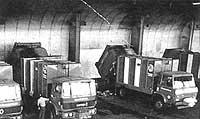New ways of treating black sludge
1992/01/01 Elhuyar Zientzia Iturria: Elhuyar aldizkaria
Millions of tons of black sludge are produced annually in water treatment plants, and what to do with them is a serious problem. In some places, such as in Britain, most are poured into the sea. However, current legislation by the EVD will prohibit the practice of this type from 1998, for endangering marine life.
There are other alternatives but with ecological and practical problems. For example, sludge can be dispersed in fields and fields, but the transport of this malicious product requires a large fleet of trucks.
On the other hand, sludge from industrial media contains a large amount of heavy metals that cannot be used as fertilizer. To reduce the volume of sludge can be coagulated and compressed before dispersion in fields and fields of cultivation. But it is not easy. Sludge can be incinerated, but in this way carbon dioxide is emitted, causing the greenhouse effect.
Wessex Water (England) and Swis Combi (Switzerland) have launched a new procedure to treat black sludge.
The sludge treatment plant only needs one operator, as the process is highly automated. The crude sludge that enters the system is mixed with the excessive grains of dry sludge that form at the end of the system. This makes the mud more compact and heats more evenly in this situation. The thickened mixture is inserted into a rotating drum where it is heated with hot air up to 450ºC. This way you get a mixture of grains. Subsequently, the specimens are screened, separating them for recycling.
Since the entire process is followed by a cycle, no odours are produced and 70% of the heat generated in the oven is recovered, being the heating efficiency of the system of 80%.
Grains are rich in nitrogen and phosphates. They can therefore be used as fertilizer. On the other hand, they can be used as fuels, since they have a calorific power equivalent to low quality coal. But if the specimens contain large amounts of heavy metals, they can be deposited in conventional landfills.

Gai honi buruzko eduki gehiago
Elhuyarrek garatutako teknologia





